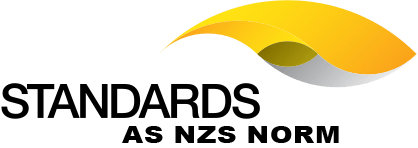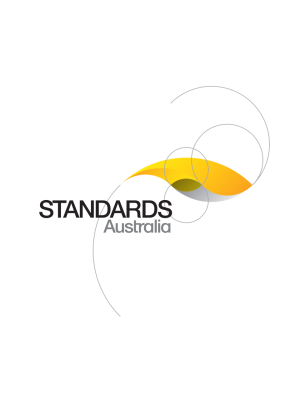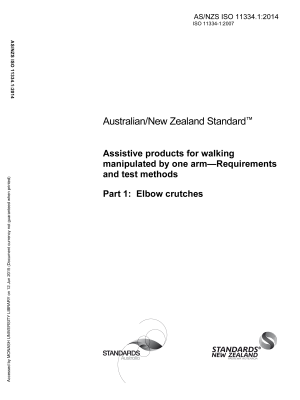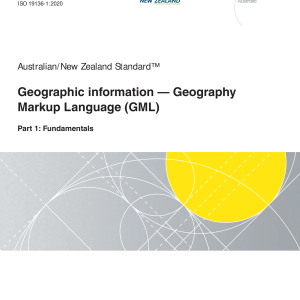🔍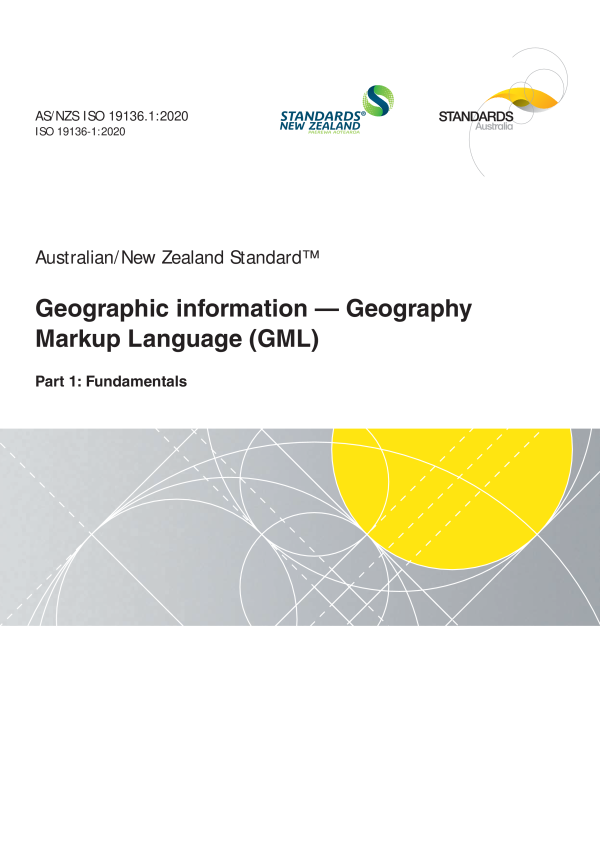

Purchase the full subscription package now and enjoy a 40% discount, along with free updates for future editions.
AS/NZS ISO 19136.1:2020
$608.55
Geographic information — Geography Markup Language (GML), Part 1: Fundamentals
Identically adopts ISO 19136 1:2020 which defines the XML Schema syntax, mechanisms and conventions that provide an open, vendor-neutral framework for the description of geospatial application schemas for the transport and storage of geographic information in XML. KEYWORDS: XML Schema; Syntax; Mechanisms; Vendor neutral framework; Geospatial application schemas; Geographic information; Transport and storage in XML.
Table of contents
Header
About this publication
Preface
Foreword
Introduction
1 Scope
2 Normative references
3 Terms, definitions, symbols and abbreviated terms
3.1 Terms and definitions
3.2 Abbreviated terms
4 Conformance
4.1 Conformance requirements
4.2 Conformance classes related to GML application schemas
4.3 Conformance classes related to GML profiles
4.4 Conformance classes related to GML documents
4.5 Conformance classes related to software implementations
5 Conventions
5.1 XML namespaces
5.2 Versioning
5.3 Deprecated parts of previous versions of GML
5.4 UML notation
5.5 XML Schema
6 Overview of the GML schema
6.1 GML schema
6.2 GML application schemas
6.3 Relationship between the ISO 19100 series of International Standards, the GML schema and GML application schemas
6.4 Organization of this document
6.5 Deprecated and experimental schema components
7 GML schema — General rules and base schema components
7.1 GML model and syntax
7.1.1 GML instance documents
7.1.2 Lexical conventions
7.1.3 XML Schema definition of GML language
7.2 gmlBase schema components
7.2.1 Goals of base schema components
7.2.2 Base objects
7.2.2.1 AbstractObject
7.2.2.2 AbstractGML, AbstractGMLType
7.2.3 GML properties
7.2.3.1 General
7.2.3.2 AssociationAttributeGroup
7.2.3.3 abstractAssociationRole, AssociationRoleType
7.2.3.4 Inline or by reference?
7.2.3.5 Ownership of property values
7.2.3.6 abstractStrictAssociationRole
7.2.3.7 abstractReference, ReferenceType
7.2.3.8 abstractInlineProperty, InlinePropertyType
7.2.3.9 Properties representing the same relationship
7.2.3.10 Properties of value objects
7.2.4 Standard properties of GML objects
7.2.4.1 Derivation from AbstractGMLType
7.2.4.2 description
7.2.4.3 descriptionReference
7.2.4.4 name, identifier
7.2.4.5 id
7.2.5 Collections of GML objects
7.2.5.1 AbstractMemberType and derived property types
7.2.5.2 GML object collections, AggregationAttributeGroup
7.2.6 Metadata
8 GML schema — Xlinks and basic types
8.1 Xlinks — Object associations and remote properties
8.2 Basic types
8.2.1 Overview
8.2.2 Relationship with ISO 19103
8.2.3 Simple types
8.2.3.1 NilReasonType
8.2.3.2 Elements declared to be “nillable”
8.2.3.3 SignType
8.2.3.4 booleanOrNilReason, doubleOrNilReason, integerOrNilReason, NameOrNilReason, stringOrNilReason
8.2.3.5 CodeType, CodeWithAuthorityType
8.2.3.6 MeasureType, UomIdentifier
8.2.3.7 CoordinatesType
8.2.4 Lists
8.2.4.1 booleanList, doubleList, integerList, NameList, NCNameList, QNameList, booleanOrNilReasonList, NameOrNilReasonList, doubleOrNilReasonList, integerOrNilReasonList
8.2.4.2 CodeListType, CodeOrNilReasonListType
8.2.4.3 MeasureListType, MeasureOrNilReasonListType
9 GML schema — Features
9.1 General concepts
9.2 Relationship with ISO 19109
9.3 Features
9.3.1 AbstractFeatureType
9.3.2 AbstractFeature
9.4 Standard feature properties
9.4.1 boundedBy, BoundingShapeType, EnvelopeWithTimePeriod, EnvelopeWithTimePeriodType
9.4.2 locationName, locationReference
9.4.3 FeaturePropertyType, FeatureArrayPropertyType
9.5 Geometry properties
9.6 Topology properties
9.7 Temporal properties
9.8 Defining application-specific feature types
9.9 Feature collections
9.9.1 GML feature collections
9.9.2 AbstractFeatureMemberType and derived property types
9.10 Spatial reference system used in a feature or feature collection
10 GML schema — Geometric primitives
10.1 General concepts
10.1.1 Overview
10.1.2 Relationship with ISO 19107
10.1.3 Abstract geometry
10.1.3.1 AbstractGeometryType
10.1.3.2 SRSReferenceGroup
10.1.3.3 SRSInformationGroup
10.1.3.4 AbstractGeometry
10.1.3.5 GeometryPropertyType
10.1.3.6 GeometryArrayPropertyType
10.1.4 Coordinate geometry, vectors and envelopes
10.1.4.1 DirectPositionType, pos
10.1.4.2 DirectPositionListType, posList
10.1.4.3 geometricPositionGroup
10.1.4.4 geometricPositionListGroup
10.1.4.5 VectorType, Vector
10.1.4.6 EnvelopeType, Envelope
10.2 Abstract geometric primitives
10.2.1 AbstractGeometricPrimitiveType, AbstractGeometricPrimitive
10.2.2 GeometricPrimitivePropertyType
10.3 Geometric primitives (0‑dimensional)
10.3.1 PointType, Point
10.3.2 PointPropertyType, pointProperty
10.3.3 PointArrayPropertyType, pointArrayProperty
10.4 Geometric primitives (1‑dimensional)
10.4.1 AbstractCurveType, AbstractCurve
10.4.2 CurvePropertyType, curveProperty
10.4.3 CurveArrayPropertyType, curveArrayProperty
10.4.4 LineStringType, LineString
10.4.5 CurveType, Curve
10.4.6 OrientableCurveType, OrientableCurve, baseCurve
10.4.7 Curve segments
10.4.7.1 AbstractCurveSegmentType, AbstractCurveSegment
10.4.7.2 CurveSegmentArrayPropertyType, segments
10.4.7.3 CurveInterpolationType
10.4.7.4 LineStringSegmentType, LineStringSegment
10.4.7.5 ArcStringType, ArcString
10.4.7.6 ArcType, Arc
10.4.7.7 CircleType, Circle
10.4.7.8 ArcStringByBulgeType, ArcStringByBulge
10.4.7.9 ArcByBulgeType, ArcByBulge
10.4.7.10 ArcByCenterPointType, ArcByCenterPoint
10.4.7.11 CircleByCenterPointType, CircleByCenterPoint
10.4.7.12 CubicSplineType, CubicSpline
10.4.7.13 BSplineType, BSpline
10.4.7.14 KnotType, KnotPropertyType
10.4.7.15 KnotTypesType
10.4.7.16 BezierType, Bezier
10.4.7.17 OffsetCurveType, OffsetCurve
10.4.7.18 AffinePlacementType, AffinePlacement
10.4.7.19 ClothoidType, Clothoid
10.4.7.20 GeodesicStringType, GeodesicString
10.4.7.21 GeodesicType, Geodesic
10.5 Geometric primitives (2‑dimensional)
10.5.1 AbstractSurfaceType, AbstractSurface
10.5.2 SurfacePropertyType, surfaceProperty
10.5.3 SurfaceArrayPropertyType, surfaceArrayProperty
10.5.4 PolygonType, Polygon
10.5.5 exterior, interior
10.5.6 AbstractRingType, AbstractRing
10.5.7 AbstractRingPropertyType
10.5.8 LinearRingType, LinearRing
10.5.9 LinearRingPropertyType
10.5.10 SurfaceType, Surface
10.5.11 OrientableSurfaceType, OrientableSurface, baseSurface
10.5.11.1 Ring, RingType, curveMember
10.5.11.2 RingPropertyType
10.5.11.3 PolyhedralSurface
10.5.11.4 TriangulatedSurface
10.5.11.5 TinType, Tin
10.5.11.6 LineStringSegmentArrayPropertyType
10.5.12 Surface patches
10.5.12.1 AbstractSurfacePatchType, gml : AbstractSurfacePatch
10.5.12.2 SurfacePatchArrayPropertyType, patches
10.5.12.3 SurfaceInterpolationType
10.5.12.4 PolygonPatchType, PolygonPatch
10.5.12.5 TriangleType, Triangle
10.5.12.6 RectangleType, Rectangle
10.5.12.7 PointGrid
10.5.12.8 AbstractParametricCurveSurfaceType, AbstractParametricCurveSurface
10.5.12.9 AbstractGriddedSurfaceType, AbstractGriddedSurface
10.5.12.10 ConeType, Cone
10.5.12.11 CylinderType, gmlCylinder
10.5.12.12 SphereType, Sphere
10.6 Geometric primitives (3‑dimensional)
10.6.1 AbstractSolidType, AbstractSolid
10.6.2 SolidPropertyType, solidProperty
10.6.3 SolidArrayPropertyType, solidArrayProperty
10.6.4 SolidType, Solid
10.6.5 ShellType, Shell
10.6.6 ShellPropertyType
11 GML schema — Geometric complex, geometric composites and geometric aggregates
11.1 Overview
11.2 Geometric complex and geometric composites
11.2.1 Geometric complex
11.2.1.1 GeometricComplexType, GeometricComplex
11.2.1.2 GeometricComplexPropertyType
11.2.2 Composite geometries
11.2.2.1 General representation of composites in GML
11.2.2.2 CompositeCurveType, CompositeCurve
11.2.2.3 CompositeSurfaceType, CompositeSurface
11.2.2.4 CompositeSolidType, CompositeSolid
11.3 Geometric aggregates
11.3.1 Aggregates of unspecified dimensionality
11.3.1.1 AbstractGeometricAggregateType, AbstractGeometricAggregate
11.3.1.2 MultiGeometryType, MultiGeometry, geometryMember, geometryMembers
11.3.1.3 MultiGeometryPropertyType, multiGeometryProperty
11.3.2 0‑Dimensional aggregates
11.3.2.1 MultiPointType, MultiPoint, pointMember, pointMembers
11.3.2.2 MultiPointPropertyType, multiPointProperty
11.3.3 1‑Dimensional aggregates
11.3.3.1 MultiCurveType, multiCurve, curveMembers
11.3.3.2 MultiCurvePropertyType, multiCurveProperty
11.3.4 2‑Dimensional aggregates
11.3.4.1 MultiSurfaceType, MultiSurface, surfaceMember, surfaceMembers
11.3.4.2 MultiSurfacePropertyType, multiSurfaceProperty
11.3.5 3‑Dimensional aggregates
11.3.5.1 MultiSolidType, MultiSolid, solidMember, solidMembers
11.3.5.2 MultiSolidPropertyType, multiSolidProperty
12 GML schema — Coordinate reference systems schemas
12.1 Overview
12.1.1 General
12.1.2 Relationship with ISO 19111
12.1.3 Important XML elements
12.2 Reference systems
12.2.1 Overview
12.2.2 IdentifiedObjectType
12.2.3 Abstract coordinate reference system
12.2.3.1 AbstractCRS
12.2.3.2 domainOfValidity
12.2.3.3 scope
12.2.3.4 CRSPropertyType
12.3 Coordinate reference systems
12.3.1 Overview
12.3.2 Abstract coordinate reference systems
12.3.2.1 AbstractSingleCRS
12.3.2.2 SingleCRSPropertyType
12.3.2.3 AbstractGeneralDerivedCRS
12.3.2.4 Conversion
12.3.3 Concrete coordinate reference systems
12.3.3.1 CompoundCRS
12.3.3.2 ComponentReferenceSystem
12.3.3.3 CompoundCRSPropertyType
12.3.3.4 GeodeticCRS
12.3.3.5 EllipsoidalCS
12.3.3.6 cartesianCS
12.3.3.7 sphericalCS
12.3.3.8 geodeticDatum
12.3.3.9 GeodeticCRSPropertyType
12.3.3.10 VerticalCRS
12.3.3.11 verticalCS
12.3.3.12 verticalDatum
12.3.3.13 VerticalCRSPropertyType
12.3.3.14 ProjectedCRS
12.3.3.15 baseGeodeticCRS
12.3.3.16 ProjectedCRSPropertyType
12.3.3.17 DerivedCRS
12.3.3.18 baseCRS
12.3.3.19 derivedCRSType
12.3.3.20 coordinateSystem
12.3.3.21 DerivedCRSPropertyType
12.3.3.22 EngineeringCRS
12.3.3.23 cylindricalCS
12.3.3.24 linearCS
12.3.3.25 polarCS
12.3.3.26 userDefinedCS
12.3.3.27 engineeringDatum
12.3.3.28 EngineeringCRSPropertyType
12.3.3.29 ImageCRS
12.3.3.30 affineCS
12.3.3.31 imageDatum
12.3.3.32 ImageCRSPropertyType
12.3.3.33 TemporalCRS
12.3.3.34 timeCS
12.3.3.35 temporalDatum
12.3.3.36 TemporalCRSPropertyType
12.4 Coordinate systems
12.4.1 Overview
12.4.2 Coordinate system axes
12.4.2.1 CoordinateSystemAxis
12.4.2.2 axisAbbrev
12.4.2.3 axisDirection
12.4.2.4 minimumValue, maximumValue, rangeMeaning
12.4.2.5 uom
12.4.2.6 CoordinateSystemAxisPropertyType
12.4.3 Abstract coordinate system
12.4.3.1 AbstractCoordinateSystem
12.4.3.2 axis
12.4.3.3 CoordinateSystemPropertyType
12.4.4 Concrete coordinate systems
12.4.4.1 EllipsoidalCS
12.4.4.2 EllipsoidalCSPropertyType
12.4.4.3 CartesianCS
12.4.4.4 CartesianCSPropertyType
12.4.4.5 VerticalCS
12.4.4.6 VerticalCSPropertyType
12.4.4.7 TimeCS
12.4.4.8 TimeCSPropertyType
12.4.4.9 LinearCS
12.4.4.10 LinearCSPropertyType
12.4.4.11 UserDefinedCS
12.4.4.12 UserDefinedCSPropertyType
12.4.4.13 SphericalCS
12.4.4.14 SphericalCSPropertyType
12.4.4.15 PolarCS
12.4.4.16 PolarCSPropertyType
12.4.4.17 CylindricalCS
12.4.4.18 CylindricalCSPropertyType
12.4.4.19 AffineCS
12.4.4.20 AffineCSPropertyType
12.5 Datums
12.5.1 Overview
12.5.2 Abstract datum
12.5.2.1 AbstractDatum
12.5.2.2 anchorDefinition
12.5.2.3 realizationEpoch
12.5.2.4 DatumPropertyType
12.5.3 Geodetic datum
12.5.3.1 GeodeticDatum
12.5.3.2 primeMeridian
12.5.3.3 ellipsoid
12.5.3.4 GeodeticDatumPropertyType
12.5.3.5 Ellipsoid, semiMajorAxis, secondDefiningParameter
12.5.3.6 EllipsoidPropertyType
12.5.3.7 PrimeMeridian, greenwichLongitude
12.5.3.8 PrimeMeridianPropertyType
12.5.4 Other concrete datums
12.5.4.1 EngineeringDatum
12.5.4.2 EngineeringDatumPropertyType
12.5.4.3 ImageDatum
12.5.4.4 pixelInCell
12.5.4.5 ImageDatumPropertyType
12.5.4.6 VerticalDatum
12.5.4.7 VerticalDatumPropertyType
12.5.4.8 TemporalDatum, origin
12.5.4.9 TemporalDatumPropertyType
12.6 Coordinate operations
12.6.1 Overview
12.6.2 Abstract coordinate operations
12.6.2.1 AbstractCoordinateOperation
12.6.2.2 operationVersion
12.6.2.3 coordinateOperationAccuracy
12.6.2.4 sourceCRS
12.6.2.5 targetCRS
12.6.2.6 CoordinateOperationPropertyType
12.6.2.7 AbstractSingleOperation
12.6.2.8 SingleOperationPropertyType
12.6.2.9 AbstractGeneralConversion
12.6.2.10 GeneralConversionPropertyType
12.6.2.11 AbstractGeneralTransformation
12.6.2.12 GeneralTransformationPropertyType
12.6.3 Concrete coordinate operations
12.6.3.1 ConcatenatedOperation
12.6.3.2 CoordOperation
12.6.3.3 ConcatenatedOperationPropertyType
12.6.3.4 PassThroughOperation
12.6.3.5 modifiedCoordinate
12.6.3.6 PassThroughOperationPropertyType
12.6.3.7 Conversion
12.6.3.8 method
12.6.3.9 parameterValue
12.6.3.10 ConversionPropertyType
12.6.3.11 Transformation
12.6.3.12 TransformationPropertyType
12.6.4 Parameter values and groups
12.6.4.1 AbstractGeneralParameterValue
12.6.4.2 AbstractGeneralParameterValuePropertyType
12.6.4.3 ParameterValue
12.6.4.4 value
12.6.4.5 stringValue
12.6.4.6 integerValue
12.6.4.7 booleanValue
12.6.4.8 valueList
12.6.4.9 integerValueList
12.6.4.10 valueFile
12.6.4.11 operationParameter
12.6.4.12 ParameterValueGroup
12.6.4.13 group
12.6.5 Operation method
12.6.5.1 OperationMethod
12.6.5.2 formula, formulaCitation
12.6.5.3 sourceDimensions
12.6.5.4 targetDimensions
12.6.5.5 parameter
12.6.5.6 OperationMethodPropertyType
12.6.6 Operation parameters and groups
12.6.6.1 GeneralOperationParameter
12.6.6.2 minimumOccurs
12.6.6.3 AbstractGeneralOperationParameterPropertyType
12.6.6.4 OperationParameter
12.6.6.5 OperationParameterPropertyType
12.6.6.6 OperationParameterGroup
12.6.6.7 maximumOccurs
12.6.6.8 OperationParameterPropertyType
13 GML schema — Topology
13.1 General concepts
13.1.1 Overview
13.1.2 Relationship with ISO 19107
13.2 Abstract topology
13.3 Topological primitives
13.3.1 Abstract topological primitives
13.3.1.1 AbstractTopoPrimitive, AbstractTopoPrimtive
13.3.2 Topological primitives (0‑dimensional)
13.3.2.1 NodeType, Node
13.3.2.2 DirectedNodePropertyType, directedNode
13.3.3 Topological primitives (1‑dimensional)
13.3.3.1 EdgeType, Edge
13.3.3.2 DirectedEdgePropertyType, directedEdge
13.3.4 Topological primitives (2‑dimensional)
13.3.4.1 FaceType, Face
13.3.4.2 DirectedFacePropertyType, directedFace
13.3.5 Topological primitives (3‑dimensional)
13.3.5.1 TopoSolidType, TopoSolid
13.3.5.2 DirectedTopoSolidPropertyType, directedTopoSolid
13.4 Topological collections
13.4.1 Topological collection (0‑dimensional)
13.4.1.1 TopoPointType, TopoPoint
13.4.1.2 TopoPointPropertyType, topoPointProperty
13.4.2 Topological collection (1‑dimensional)
13.4.2.1 TopoCurveType, TopoCurve
13.4.2.2 TopoCurvePropertyType, topoCurveProperty
13.4.3 Topological collection (2‑dimensional)
13.4.3.1 TopoSurfaceType, TopoSurface
13.4.3.2 TopoSurfacePropertyType, topoSurfaceProperty
13.4.4 Topological collection (3‑dimensional)
13.4.4.1 TopoVolumeType, TopoVolume
13.4.4.2 TopoVolumePropertyType, topoVolumeProperty
13.5 Topology complex
13.5.1 TopoComplexType, TopoComplex
13.5.2 Maximal, sub- and super-complexes
13.5.3 topoPrimitiveMember
13.5.4 topoPrimitiveMembers
13.5.5 TopoComplexPropertyType, topoComplexProperty
14 GML schema — Temporal information and dynamic features
14.1 General concepts
14.1.1 Overview
14.1.2 Relationship with ISO 19108
14.2 Temporal schema
14.2.1 Abstract temporal objects
14.2.1.1 AbstractTimeObject
14.2.1.2 AbstractTimePrimitive
14.2.1.3 TimePrimitivePropertyType, validTime
14.2.1.4 RelatedTimeType
14.2.1.5 AbstractTimeComplex
14.2.2 Temporal geometry
14.2.2.1 General
14.2.2.2 AbstractTimeGeometricPrimitive
14.2.2.3 TimeInstant
14.2.2.4 TimeInstantPropertyType
14.2.2.5 TimePeriod
14.2.2.6 TimePeriodPropertyType
14.2.2.7 TimePositionType, timePosition
14.2.2.8 timeLength, duration, timeInterval, TimeUnitType
14.3 Temporal topology schema
14.3.1 General
14.3.2 Temporal topology objects
14.3.2.1 Overview
14.3.2.2 AbstractTimeTopologyPrimitive
14.3.2.3 TimeTopologyPrimitivePropertyType
14.3.2.4 TimeTopologyComplex
14.3.2.5 TimeTopologyComplexPropertyType
14.3.2.6 TimeNode
14.3.2.7 TimeNodePropertyType
14.3.2.8 TimeEdge
14.3.2.9 TimeEdgePropertyType
14.4 Temporal reference systems
14.4.1 Overview
14.4.2 Basic temporal reference system, TimeReferenceSystem
14.4.3 TimeCoordinateSystem
14.4.4 Calendars and clocks
14.4.4.1 Overview
14.4.4.2 TimeCalendar, TimeCalendarEra
14.4.4.3 TimeCalendarPropertyType, TimeCalendarEraPropertyType
14.4.4.4 TimeClock
14.4.4.5 TimeClockPropertyType
14.4.5 Ordinal temporal reference systems
14.4.5.1 Overview
14.4.5.2 TimeOrdinalReferenceSystem, TimeOrdinalEra
14.4.5.3 TimeOrdinalEraPropertyType
14.5 Representing dynamic features
14.5.1 Overview
14.5.2 dataSource
14.5.3 Dynamic properties
14.5.4 DynamicFeature
14.5.5 DynamicFeatureCollection
14.5.6 AbstractTimeSlice
14.5.7 history
15 GML schema — Definitions and dictionaries
15.1 Overview
15.2 Dictionary schema
15.2.1 Definition, DefinitionType, remarks
15.2.2 Dictionary, DictionaryType
15.2.3 dictionaryEntry, DictionaryEntryType
15.2.4 Using definitions and dictionaries
16 GML schema — Units, measures and values
16.1 Introduction
16.2 Units schema
16.2.1 Overview
16.2.2 Using unit definitions
16.2.3 unitOfMeasure, UnitOfMeasureType
16.2.4 UnitDefinition, UnitDefinitionType
16.2.5 quantityType, quantityTypeReference
16.2.6 catalogSymbol
16.2.7 BaseUnit, BaseUnitType, unitsSystem
16.2.8 DerivedUnit, DerivedUnitType
16.2.9 derivationUnitTerms, DerivationUnitTermType
16.2.10 ConventionalUnit, ConventionalUnitType
16.2.11 conversionToPreferredUnit, roughConversionToPreferredUnit, ConversionToPreferredUnitType, FormulaType
16.2.12 Example of units dictionary <informative>
16.3 Measures schema
16.3.1 Overview
16.3.2 measure
16.3.3 Scalar measure types
16.3.4 angle
16.4 Value objects schema
16.4.1 Introduction
16.4.2 Value element hierarchy
16.4.3 Boolean, BooleanList
16.4.4 Category, CategoryList
16.4.5 Count, CountList
16.4.6 Quantity, QuantityList
16.4.7 AbstractValue, AbstractScalarValue, AbstractScalarValueList
16.4.8 Value
16.4.9 valueProperty, valueComponent, valueComponents
16.4.10 CompositeValue
16.4.11 ValueArray
16.4.12 Typed ValueExtents: CategoryExtent, CountExtent, QuantityExtent
16.4.13 BooleanPropertyType, CategoryPropertyType, CountPropertyType, QuantityPropertyType
17 GML schema — Directions
17.1 Direction schema
17.2 direction, DirectionPropertyType
17.3 DirectionVectorType
17.4 DirectionDescriptionType
18 GML schema — Observations
18.1 Observations
18.2 Observation schema
18.2.1 Overview
18.2.2 Observation
18.2.3 using
18.2.4 target
18.2.5 resultOf
18.2.6 DirectedObservation
18.2.7 DirectedObservationAtDistance
19 GML schema — Coverages
19.1 The coverage model and representations
19.1.1 General remarks
19.1.2 Formal description of a coverage
19.1.3 Coverage in GML
19.1.4 Relationship with ISO 19123
19.2 Grids schema
19.2.1 Overview
19.2.2 Grid
19.2.3 RectifiedGrid
19.3 Coverage schema
19.3.1 AbstractCoverageType, AbstractCoverage
19.3.2 DiscreteCoverageType, AbstractDiscreteCoverage
19.3.3 AbstractContinuousCoverageType, AbstractContinuousCoverage
19.3.4 domainSet, DomainSetType
19.3.5 rangeSet, RangeSetType
19.3.6 DataBlock
19.3.7 rangeParameters
19.3.8 tupleList
19.3.9 doubleOrNilReasonTupleList
19.3.10 File, FileType
19.3.11 coverageFunction, CoverageFunctionType
19.3.12 CoverageMappingRule
19.3.13 GridFunction, GridFunctionType
19.3.14 sequenceRule, SequenceRuleType, SequenceRuleEnumeration
19.3.15 Specific Coverage Types in GML
19.3.16 MultiPointCoverage
19.3.17 MultiCurveCoverage
19.3.18 MultiSurfaceCoverage
19.3.19 MultiSolidCoverage
19.3.20 GridCoverage
19.3.21 RectifiedGridCoverage
20 Profiles
20.1 Profiles of GML and application schemas
20.2 Definition of profile
20.3 Relation to application schema
20.4 Rules for elements and types in a profile
20.5 Rules for referencing GML profiles from application schemas
20.6 Recommendations for application schemas using GML profiles
20.7 Summary of rules for GML profiles
21 Rules for GML application schemas
21.1 Instances of GML objects
21.1.1 GML documents
21.1.2 GML object elements in other XML documents
21.2 GML application schemas
21.2.1 General
21.2.2 Target namespace
21.2.3 Import GML schema
21.2.4 Object type derivation
21.2.5 Elements representing objects
21.2.6 Property type derivation
21.2.7 Elements representing properties
21.3 Schemas defining Features and Feature Collections
21.3.1 General
21.3.2 Import GML schema components
21.3.3 Elements representing features
21.3.4 Application features are features
21.4 Schemas defining spatial geometries
21.4.1 Import GML geometry schema components
21.4.2 User-defined geometry types and geometry property types
21.4.2.1 User-defined geometry types
21.4.2.2 User-defined geometry property types
21.5 Schemas defining spatial topologies
21.5.1 Import GML topology schema components
21.5.2 User-defined topology types and topology property types
21.5.2.1 User-defined topology types
21.5.2.2 User-defined topology property types
21.6 Schemas defining time
21.6.1 Import GML temporal schema components
21.6.2 User-defined temporal types and temporal property types
21.6.2.1 User-defined temporal types
21.6.2.2 User-defined temporal property types
21.7 Schemas defining coordinate reference systems
21.7.1 General
21.7.2 Import GML coordinate reference system schema components
21.8 Schemas defining coverages
21.8.1 General
21.8.2 Import GML coverage schema components
21.8.3 User-defined coverage types
21.8.4 Range parameters shall be substitutable for AbstractValue
21.8.5 Coverage document
21.9 Schemas defining observations
21.9.1 General
21.9.2 Import GML observation schema components
21.9.3 User-defined observation types
21.9.4 Observation collections
21.9.5 Observations are features
21.9.6 Observation collection document
21.10 Schemas defining dictionaries and definitions
21.10.1 General
21.10.2 Import GML dictionary schema components
21.10.3 User-defined definition types
21.10.4 User-defined dictionary types
21.11 Schemas defining values
21.11.1 General
21.11.2 Import GML value objects schema components
21.11.3 Construction of new value types
21.12 GML profiles of the GML schema
Annex A
A.1 Abstract test suite for GML application schemas
A.1.1 Test cases for mandatory conformance requirements
A.1.1.1 Use of XML namespaces
A.1.1.2 General rules
A.1.1.3 Import of GML schema components
A.1.1.4 Valid XML Schema
A.1.1.5 Support for the GML model and syntax
A.1.1.6 Substitution group of object elements, type derivation
A.1.1.7 Property elements are not object elements
A.1.1.8 Content model of property elements
A.1.1.9 Metadata and data quality properties
A.1.1.10 Spatial geometry properties
A.1.1.11 Spatial topology properties
A.1.1.12 Temporal properties
A.1.1.13 Location properties
A.1.1.14 GML object collections
A.1.1.15 Substitution group of feature elements
A.1.1.16 GML feature collections
A.1.2 Test cases for GML application schemas converted from an ISO 19109 Application Schema in UML
A.1.2.1 Valid ISO 19109 Application Schema
A.1.2.2 Mapping from an ISO 19109 Application Schema in UML
A.1.3 Test cases for ISO 19109 Application Schemas in UML converted from a GML application schema
A.1.3.1 Valid GML application schema
A.1.3.2 Mapping to an ISO 19109 Application Schema in UML
A.1.4 GML application schemas defining features and feature collections
A.1.5 GML application schemas defining spatial geometries
A.1.6 GML application schemas defining spatial topologies
A.1.7 GML application schemas defining time
A.1.8 GML application schemas defining coordinate reference systems
A.1.9 GML application schemas defining coverages
A.1.10 GML application schemas defining observations
A.1.11 GML application schemas defining dictionaries and definitions
A.1.12 GML application schemas defining values
A.2 Abstract test suite for GML profiles
A.2.1 Valid GML profile
A.2.2 Geometric primitives (spatial)
A.2.2.1 Data types for geometric primitives
A.2.2.1.1 Data types for 0‑dimensional geometry
A.2.2.1.2 Data types for 1‑dimensional geometry
A.2.2.1.3 Data types for 2‑dimensional geometry
A.2.2.1.4 Data types for 3‑dimensional geometry
A.2.3 Geometric complexes (spatial)
A.2.3.1 Data types for geometric complexes
A.2.3.1.1 Data types for 1‑dimensional geometric complexes
A.2.3.1.2 Data types for 2‑dimensional geometric complexes
A.2.3.1.3 Data types for 3‑dimensional geometric complexes
A.2.4 Topologic complexes (spatial)
A.2.4.1 Data types for topologic complexes
A.2.4.1.1 Data types for 1‑dimensional topologic complexes
A.2.4.1.2 Data types for 2‑dimensional topologic complexes
A.2.4.1.3 Data types for 3‑dimensional topologic complexes
A.2.5 Topologic complexes with geometric realization (spatial)
A.2.5.1 Data types for topologic complexes with geometric realization
A.2.5.1.1 Data types for 1‑dimensional topologic complexes with geometric realization
A.2.5.1.2 Data types for 2‑dimensional topologic complexes with geometric realization
A.2.5.1.3 Data types for 3‑dimensional topologic complexes with geometric realization
A.2.6 Coordinate reference systems
A.2.7 Coordinate operations
A.2.8 Temporal geometry
A.2.8.1 Data types for 0‑dimensional geometry
A.2.8.2 Data types for 1‑dimensional geometry
A.2.9 Temporal topology
A.2.10 Temporal reference systems
A.2.11 Dynamic features
A.2.12 Dictionaries
A.2.13 Units dictionaries
A.2.14 Observations
A.2.15 Coverages
A.2.15.1 Abstract coverage
A.2.15.2 Discrete point coverage
A.2.15.3 Discrete curve coverage
A.2.15.4 Discrete surface coverage
A.2.15.5 Discrete solid coverage
A.2.15.6 Grid coverage
A.2.15.7 Continuous coverage
A.3 Abstract test suite for GML documents
A.3.1 Existence of a reference to an applicable GML application schema
A.3.2 Existence of the referenced GML application schema
A.3.3 Conformance of the referenced GML application schema
A.3.4 Valid XML
A.3.5 Conformance of a GML document
Annex B
B.1 Test cases for mandatory conformance requirements
B.1.1 GML profile
B.1.2 Support for local simple Xlinks
B.1.3 Coordinate reference systems used in features (software implementation)
B.2 Test cases for optional conformance requirements for software implementations with the capability to process GML object elements in XML format
B.2.1 Support for remote simple Xlinks
B.2.2 Support for extended Xlinks
B.2.3 Support for nillable properties
B.2.4 Support for units of measurement
B.2.5 Support for ownership semantics of properties
B.2.6 Metadata properties
B.2.7 Support for GML profiles in instance validation
B.3 Test cases for writing GML
B.3.1 Serialization capability
B.3.2 Serialization validity
B.4 Test case for reading GML
B.5 Test cases for writing GML application schemas
B.5.1 Serialization capability
B.5.2 Serialization validity
B.6 Test cases for reading GML application schemas
Annex C
Annex D
D.1 General remarks
D.2 Profile of the ISO 19100 series of International Standards used by GML
D.2.1 Overview
D.2.2 ISO/TS 19103 Conceptual schema language
D.2.3 ISO 19107 Spatial schema (Geometry)
D.2.3.1 Overview
D.2.3.2 Geometry root
D.2.3.3 Geometry primitive
D.2.3.4 Coordinate Geometry
D.2.3.5 Geometry aggregates
D.2.3.6 Geometry complex
D.2.3.7 Conformance
D.2.4 ISO 19107 spatial schema (topology)
D.2.4.1 Overview
D.2.4.2 Topology root
D.2.4.3 Topology primitive
D.2.4.4 Topology complex
D.2.4.5 Conformance
D.2.5 ISO 19108 Temporal schema
D.2.5.1 Overview
D.2.5.2 Temporal objects
D.2.5.3 Concrete temporal geometric primitives
D.2.5.4 Temporal duration
D.2.5.5 Temporal position
D.2.5.6 Temporal topology
D.2.5.7 Temporal reference systems
D.2.5.8 Calendars and clocks
D.2.5.9 Time coordinate systems
D.2.5.10 Temporal ordinal reference system
D.2.5.11 Conformance
D.2.6 ISO 19109 rules for application schema
D.2.6.1 GML implements a subset of the general feature model defined in ISO 19109.
D.2.7 ISO 19111 spatial referencing by coordinates
D.2.7.1 Overview
D.2.7.2 Identified object package
D.2.7.3 Coordinate reference system package
D.2.7.4 Coordinate system package
D.2.7.5 Datum package
D.2.7.6 Coordinate operation package
D.2.8 ISO 19112 spatial referencing by geographic identifiers
D.2.9 ISO 19115 metadata
D.2.10 ISO 19118 encoding
D.2.11 ISO 19123 coverages
D.3 Extension of the profile of the ISO 19100 series of International Standards
D.3.1 Overview
D.3.2 Package “basicTypes”
D.3.3 Package “gmlBase”
D.3.4 Package “feature”
D.3.5 Package “geometryBasic0d1d”
D.3.6 Package “geometryBasic2d”
D.3.7 Package “geometryPrimitives”
D.3.8 Package “geometryAggregates”
D.3.9 Packages “coordinateOperations”, “coordinateReferenceSystems”, “coordinateSystems”, “dataQuality”, “datums”, “referenceSystems”
D.3.9.1 Overview
D.3.9.2 UML schema of package “coordinateReferenceSystems”
D.3.9.3 UML schema of package “coordinateSystems”
D.3.9.4 UML schema of package “datums”
D.3.10 Package “topology”
D.3.11 Package “dynamicFeature”
D.3.12 Package “dictionary”
D.3.13 Package “units”
D.3.14 Package “measures”
D.3.15 Package “valueObjects”
D.3.16 Package “direction”
D.3.17 Package “observation”
Annex E
E.1 General concepts
E.2 Encoding rules
E.2.1 General encoding requirements
E.2.1.1 Application schemas
E.2.1.1.1 General (application schema, packages)
E.2.1.1.2 Classes
E.2.1.1.3 Attributes
E.2.1.1.4 Associations and association ends
E.2.1.1.5 Predefined types
E.2.1.1.6 OCL constraints
E.2.1.1.7 Other information
E.2.1.2 Character repertoire and languages
E.2.1.3 Exchange metadata
E.2.1.4 Dataset and object identification
E.2.1.5 Update mechanism
E.2.2 Input data structure
E.2.3 Output data structure
E.2.4 Conversion rules
E.2.4.1 General concepts
E.2.4.2 UML packages
E.2.4.3 UML classes (general rules)
E.2.4.4 UML classes (basic types)
E.2.4.5 UML classes (data types)
E.2.4.6 UML classes (feature types)
E.2.4.7 UML classes (object types)
E.2.4.8 UML classes (enumerations)
E.2.4.9 UML classes (code lists)
E.2.4.10 UML classes (unions)
E.2.4.11 UML attributes and association roles
E.2.4.12 Documentation
E.2.4.13 Classes imported from the ISO 19100 series of International Standards
E.2.4.14 Classes imported from other conceptual models with a predefined XML encoding
E.3 Example <informative>
Annex F
F.1 General concepts
F.2 Encoding rules
F.2.1 General encoding requirements
F.2.1.1 General remarks
F.2.1.2 GML schema
F.2.1.2.1 General
F.2.1.2.2 GML object types including GML feature types
F.2.1.2.3 Global elements for gml object types
F.2.1.2.4 Default property types for gml object types
F.2.1.2.5 Inline property types for gml object types
F.2.1.2.6 GML data types including GML union types
F.2.1.2.7 Default property types for GML data types
F.2.1.2.8 Enumerations
F.2.1.2.9 Code lists
F.2.1.2.10 Global elements for GML data types, enumerations and code lists
F.2.1.2.11 Predefined basic types
F.2.1.2.12 GML properties
F.2.1.2.13 Schematron constraints
F.2.1.2.14 Imported elements and types from other XML namespaces
F.2.1.2.15 Other information
F.2.1.3 Character repertoire and languages
F.2.1.4 Exchange metadata
F.2.1.5 Dataset and object identification
F.2.1.6 Update mechanism
F.2.1.7 Input data structure
F.2.2 Output data structure
F.2.3 Conversion rules
F.2.3.1 General concepts
F.2.3.2 GML schema documents
F.2.3.3 GML object types
F.2.3.4 GML object types (imported from the GML schema)
F.2.3.5 Basic types
F.2.3.6 GML data types
F.2.3.7 Enumerations
F.2.3.8 Code lists
F.2.3.9 GML properties
F.2.3.10 Documentation
Annex G
G.1 General
G.2 depends.xslt
G.3 gmlSubset.xslt
G.4 utility.xslt
Annex H
H.1 General
H.2 Top-level styling elements
H.2.1 Overview
H.2.2 defaultStyle
H.2.3 Style
H.3 Feature style
H.3.1 FeatureStyle
H.3.2 featureType
H.3.3 baseType
H.3.4 featureConstraint
H.3.5 queryGrammar
H.4 Geometry style
H.5 Topology style
H.6 Label style
H.7 Common styling elements
H.7.1 Overview
H.7.2 symbol
H.7.3 styleVariation
H.7.4 spatialResolution
H.7.5 animation
H.8 Graph style
Annex I
I.1 Overview
I.2 Base schema components
I.2.1 remoteSchema
I.2.2 member
I.2.3 ArrayAssociationType
I.2.4 members
I.2.5 featureProperty, featureMember, featureMembers
I.2.6 StringOrRefType
I.2.7 Array, ArrayType, Bag, BagType
I.2.8 metaDataProperty, MetaDataPropertyType, AbstractMetaData, AbstractMetaDataType
I.2.9 GenericMetaData, GenericMetaDataType
I.3 Basic types, Null
I.4 Features
I.4.1 location, LocationPropertyType, LocationKeyWord, LocationString
I.4.2 priorityLocation, priorityLocationType
I.4.3 BoundedFeatureType
I.4.4 AbstractFeatureCollectionType, AbstractFeatureCollection, FeatureCollection, FeatureCollectionType
I.4.5 Spatial properties
I.5 Coordinate geometry, geometric primitives
I.5.1 coordinates
I.5.2 pos in EnvelopeType
I.5.3 pointRep
I.5.4 polygonPatches
I.5.5 trianglePatches
I.6 Coordinate reference systems
I.6.1 baseGeographicCRS
I.6.2 GeographicCRS
I.6.3 GeocentricCRS
I.6.4 uom
I.6.5 ObliqueCartesianCS
I.6.6 TemporalCS
I.6.7 greenwichLongitude
I.6.8 AbstractOperation
I.6.9 dmsAngleValue
I.6.10 Renamed property elements
I.6.11 …Ref property elements
I.7 Temporal information and dynamic features
I.7.1 SuccessionType
I.7.2 MovingObjectStatus
I.7.3 track
I.8 Definitions and dictionaries
I.8.1 DefinitionCollection
I.8.2 definitionMember
I.8.3 indirectEntry, IndirectEntryType, DefinitionProxy, DefinitionProxyType
I.9 Units, measures and values
I.9.1 dmsAngle
I.9.2 degrees
I.9.3 decimalMinutes
I.9.4 minutes
I.9.5 seconds
I.9.6 AngleChoiceType
I.10 Directions
I.11 Coverages
I.11.1 MappingRule
I.11.2 IncrementOrder
I.11.3 Domain set properties
Annex J
Bibliography
Cited references in this standard
Content history
[Current]
[Superseded]
DR AS/NZS ISO 19136.1:2020
AS/NZS ISO 19136-2008 REC:2018
Please select a variation to view its description.
| Published | 28/08/2020 |
|---|---|
| Pages | 367 |
Please select a variation to view its pdf.
